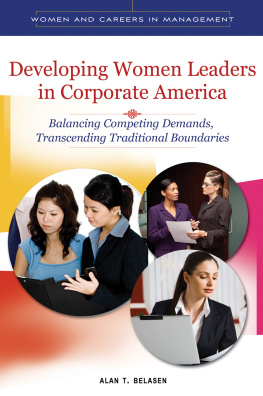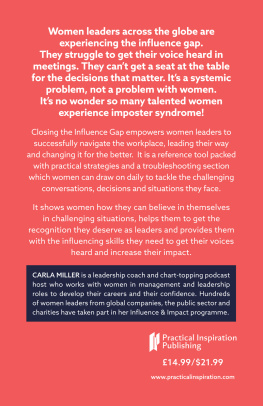Acknowledgments
First and foremost I would like to thank my wife, Susan, for her steadfast support and unparalleled encouragement to accomplish the task of writing this book. I am also indebted to my five As: Ari, Amy, Anat, Amanda, and Abby whose creative ideas and constructive criticisms helped shape some of my thinking about this book and its purpose.
Special thanks to Michele Paludi, Series Editor, renowned human resource management professor, author of many books, and expert on diversity in leadership for her confidence, guidance, and feedback. Brian Romer, Senior Acquisitions Editor, was enormously helpful in bringing the manuscript to closure. Robin Tutt, Submissions Coordinator, was helpful in the pre-production phase of this book.
Many thanks to Dr. Nancy Frank, my colleague and research partner, for the years of working together on numerous research projects leading to conference papers, book chapters, and journal articles. Nancys influence on my thinking is well reflected in this book. My colleague, Elliot Luber, was instrumental in providing insights and ideas for this book. Much appreciation goes to Dr. Nancy Kymn Rutigliano whose expertise in the area of crisis leadership and whistle-blowing has helped shape important sections of this book. I would also like to acknowledge the insights and ideas that Dr. Rosalyn Rufer, my colleague, provided while I was working on the different drafts of this book. I am very grateful to Dr. Laura Schweitzer, President, Union Graduate College, for her insights, encouragement, and support.
I am especially thankful to the many graduate students at the University at Albany who attended my leadership communication course and helped refine my thinking about many of the issues and topics raised in this book. Special mention goes to: Naomi Krakower, Jaclyn Holmes, Kelly Tu, Jessica Dillard, Shuang Zhao, Jessie Festa, Liwen Tang, Amanda Thompson, Theresa Gasper, Pornchanok Tuancharoensri, Sandra Lynn Pabis, Georgianna Rowe, and Rana Fayez. Many professionals contributed to the sections on self assessment and self improvement: Hermeata Porcher, Megan Campbell, AnnMarie Hutchison, Wendy Coonrod, Amanda Mitchum, April Coulson, Melissa Leander, Kimberly Stackhouse, Ana Maria Chanaba, and David Kamen. Thanks goes to the Office of Academic Affairs, SUNY-Empire State College, for providing the research funds to support the research for this book.
Special thanks to my mother, Daisy Belasen, for her constant support and confidence in my ability to bring this book to fruition. Thanks for your inspirational motivation, Ema.
Alan
About the Author
Alan T. Belasen, PhD, is professor of management and chair of the business, management, and leadership programs at State University of New York, Empire State College. He holds degrees from the Hebrew University, Jerusalem, Israel, and State University of New York at Albany. He has taught organizational behavior, leadership communication, human resources, international business, and corporate communication at the University at Albany, and the AACSB Accredited MBA program at Union Graduate College. His published works include Leading the Learning Organization: Communication and Competencies for Managing Change and The Theory and Practice of Corporate Communication: A Competing Values Perspective. His most recent articles appear in Leadership & Organization Development Journal; Journal of Human Resource Management; International Journal of Human Resources Development and Management; The Journal of Health Administration Education; The Atlantic Journal of Communication; The International Journal of Leadership Studies; and the Proceedings of the Academy of Management. Belasen also contributed chapters in a number of books on topics such as self-managed work teams, womens leadership, and executive education.
1
The Catch 22 of Womens Leadership
During the 1960s and 1970s womens participation in the workforce has reached 40% with women primarily occupying professions such as teaching, nursing, and social work. The majority of women were still in nonmanagement positions due to the prevailing assumption that managerial responsibilities require managers to be assertive, with an analytic mindset and with commitment that transcends regular work time. Hence, women filled support staff positions such as assistants and secretaries. With the passage of the 1964 Civil Rights Act that made discrimination in employment unlawful on the basis of gender, race, and social status, women began to chisel away at the concrete wall that buffered them from reaching managerial positions that traditionally have been the exclusive territory of men. The concrete wall began to crack in the 1970s and 1980s when women were advancing to lower middle management positions. Nevertheless they were still excluded from top executive jobs.
In the 1990s, as organizations have begun shifting away from vertical structures rooted in male conceptions of power that emphasize command and control approaches toward horizontal structures of management based on commitment and empowerment, new values such as diversity, participation, integrity, trust, honesty, and inclusion have also signaled a shift to a new management paradigm. This new paradigm involved a shift from transactional management to transformational leadership; and from command structures designed exclusively around reporting and compliance to commitment structures emphasizing relational power and open communication lines. Upper management was expected to shift from taking charge to taking care and was evaluated on abilities to transform people and organizations, not only transact around core business competencies.
Todays flatter, team-based organizations are no longer looking for top-down authority figures but for more collaborative and inclusive approaches to leadership based on facilitative power and consultation. Leadership is becoming more interactive, and womens style of leadership seems to be more appropriate than that of mens in diversified and globalized work environments (Daft, 2011). Moreover, the past 40 years marked a significant transformation in womens participation in the labor force. The U.S. Bureau of Labor Statistics (2009, p. 8) reported that womens proportion in the civilian labor force increased steadily from 43.3% in 1970 to 59.5% in 2008. Women have also increasingly attained college degrees. Among women aged 25 to 64 who are in the labor force, the proportion with a college degree roughly tripled from 1970 to 2008. Womens earnings as a proportion of mens earnings also have grown over time. In 1979, women working full time earned 62% of what men did; in 2008, womens earnings were 80% of mens (U.S. Bureau of Labor Statistics, 2009).
At the same time, the question remains of why more women, whose feminine gender role suggests teamwork, empowerment, sharing information, and caring for employees, have not yet shattered the metaphorical glass ceiling. Why are women grossly underrepresented in boardrooms and executive suites?
In 2007, McKinsey & Company, an international management consulting firm, conducted a study to offer valuable insight regarding the importance of female representation within top management positions. The report, Women Matter: Gender diversity, a corporate performance driver, documented the reasons that hinder diversity in senior management positions. The study predominantly focused on European companies, providing evidence that gender gaps are palpable globally. Interestingly, the study also pointed out that companies where women are most strongly represented at board or top-management levels are also the companies that perform best (McKinsey & Company, 2007, p. 3). If companies truly do perform best when women hold top positions, one might wonder why gender gaps persist.









